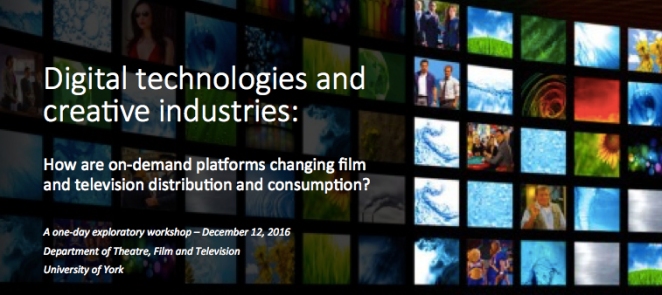12 December 2016, Department of Theatre, Film and Television, University of York
As part of the initial groundwork for the project, our first workshop brought together a group of 15 academics from the University of York, King’s College London, the University of Manchester and Newcastle University. Project leader Andrew Higson reports on key themes and issues that emerged from the discussion.

The emergence of new technologies for delivering cultural products to consumers has opened the field to dynamic digital disruptors and fuelled claims about the democratisation of access and the enhancement of choice. In this vision, content creators of all shapes and sizes have access to new online distribution outlets and consumers or users have access to a huge range of cultural products through those same outlets.
Our workshop set out to investigate some of the ways in which content creators, firms small and large, and consumers and users negotiate this new field. The speakers underlined the extent to which we live in an era of intense media convergence, in which films and television programmes become content to be exploited across a range of platforms, and in which broadcasters must work with broadband providers, internet services, mobile phone operators, media storage businesses and so on. They also underlined the fact that established modes of formal, professionally created film and television content must jostle for attention with a huge wealth of user-generated stories and entertainment on platforms such as YouTube.

A series of pressing questions emerged from the discussion. How has the development of the on-demand culture impacted on the way this particular branch of the creative industries creates and disseminates content and the way consumers engage with that content? What is the impact of recent technological developments on content creation, distribution and consumption? How do content creators respond to changing modes of consumption? How do firms large and small, incumbents and new entrants, respond organisationally and strategically to technological change, and what is the relationship between the dynamics of business renewal and the dynamics of business disruption?
Distinctions were made between formal and informal media economies (Lobato and Thomas 2015). It became clear that those distinctions are by no means clear-cut, and are better understood as points on a spectrum. At one end of the spectrum, we can find high-budget, professionally produced and institutionally regulated drama on platforms such as Netflix. At the other end of the spectrum, we can find the same content being traded illegally via peer-to-peer file sharing, but also low to no-budget user-generated content distributed by the makers direct to consumers. Somewhere in the middle lies YouTube, where some user-generated content can reach audiences of millions.
Blurring the boundary between the formal and the informal, YouTube is big business, not least as a new means of delivering audiences to advertisers. Equally, the informal end of the media economy can swiftly become formalised, as can be seen in the way second screening and social media opportunities are exploited by large, formal media companies.

The blurring of the boundary between the formal and the informal economy can also be seen in the dynamic interplay between incumbents and new entrants. Firms such as Amazon and Netflix are still relatively new entrants in the business of film and television distribution, and they have disrupted established ways of operating by exploiting the potential of online distribution and the on-demand culture.
But if they are on the one hand disruptors, they are already major corporations and the new incumbents. The overall dynamics of power in the film and television business thus remain very similar, even if some of the most successful players have changed. These new incumbents may be just as powerful as the Hollywood studios, but like those studios they are still part of a hugely complex and fragmented network of content creators, intermediaries, and content providers seeking to generate revenue streams and monetise content across a range of markets.
To some observers, the film business seems to have gone through a process of disintermediation, with digital platforms seemingly allowing a direct relationship between producers and consumers. Others observe an equally swift re-intermediation of the business, with the establishment of new intermediaries such as content aggregators, and other distribution agents still vital to the process of securing formal arrangements with theatrical and online service providers.
The promise that digital technologies would democratise content creation and that the economics of the digital long tail would enable online providers to offer a huge range of niche video content has had mixed results. Some workshop participants pointed to the enormous popularity of user-generated content on platforms such as YouTube. Others focused on the formal economy and noted that there is still a very restrictive power dynamics at play and that it was difficult for non-mainstream films and television programmes to secure the level of visibility in the over-populated digital world that would enable them to become economically viable.

The visibility of much of the film content on VOD platforms still clearly depends to a great extent on relatively traditional marketing around the theatrical release for those films. But the visibility of content online also depends increasingly on recommender systems. Mainstream platforms such as Netflix and Amazon are organised around complex recommender algorithms. Smaller, more specialised platforms such as Mubi for film and Walter Presents for television drama present themselves as ‘anti-algorithmic’ curated spaces, where a small amount of carefully selected material is made available to consumers.
These are two different systems for recommending viewing experiences; as such, they are two different means of cultural gatekeeping, two different means of shaping and reinforcing taste. Curated sites function more like public service operators, presenting the curator as the guardian of ‘good taste’, who knows their ‘culture’. Algorithmic platforms on other hand profess to know the individual consumer and to make recommendations based on that personalised knowledge. They are part of what some have called a ‘knowing’ capitalism, which knows who the consumers are, what we like to consume and how, and tailors content creation and access accordingly.
Both of these recommender systems assume an established individual taste that can be maintained and expanded through recommendations; both assume they know what is good for us. They offer different ways of shaping social experience, cultural taste and consumer behaviour. But if both systems are about filtering, selecting and prioritising, the algorithmic system is also about gathering personalised information, measuring consumer behaviour and using big data to predict taste.

One of the challenges in making sense of these new developments is accessing the data and other evidence that can help us understand what is at stake. On the one hand, as workshop participants demonstrated, there are huge amounts of data available through the likes of YouTube and recently established online media enterprises such as eSports. On the other hand, as many media researchers are only too aware, it is extraordinarily difficult to gain access to rich, business-sensitive data about the online viewing of films and television content on platforms such as Amazon and Netflix.
The data that is available suggests that the viewing of films and long-form TV drama has increased rapidly over the last few years, while the physical disc (BluRay and DVD) business is equally rapidly disappearing. However, the online viewing of films has had no apparent impact as yet on the theatrical market, which remains relatively buoyant.
Theatrical exhibition thus remains a vital part of the market for the formal, professional end of the business, although theatrical and online distribution are increasingly converging. Day-and-date releases, for instance, launch films simultaneously across a variety of platforms, including the theatrical ‘platform’.
